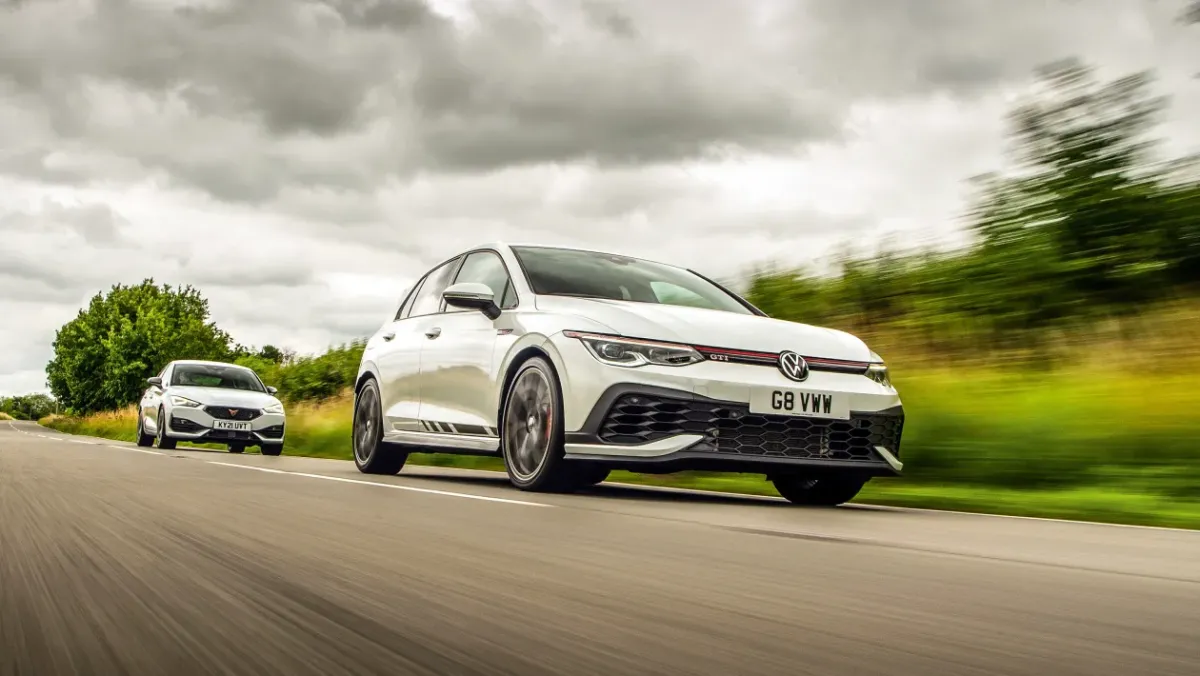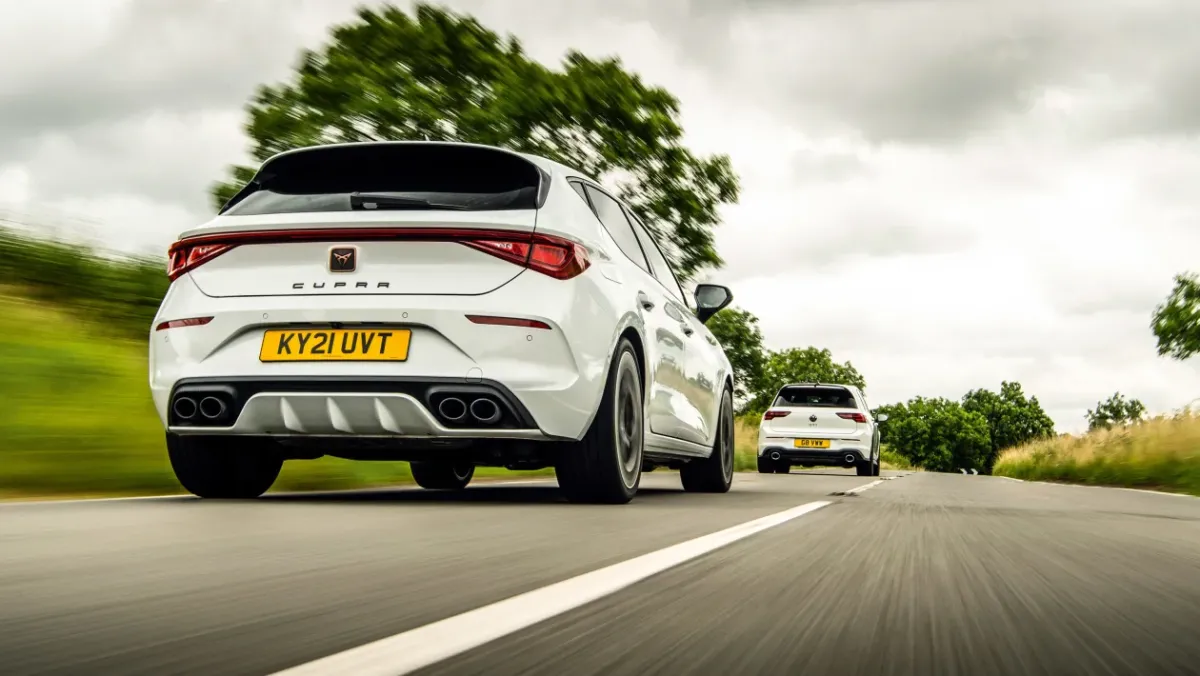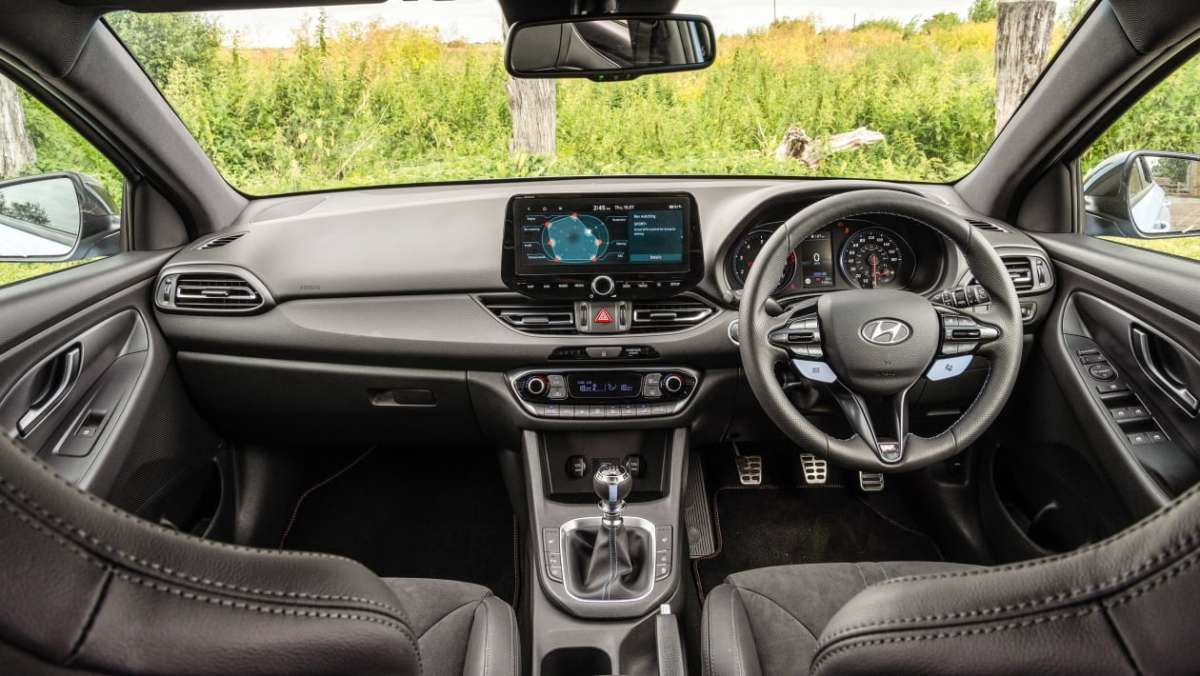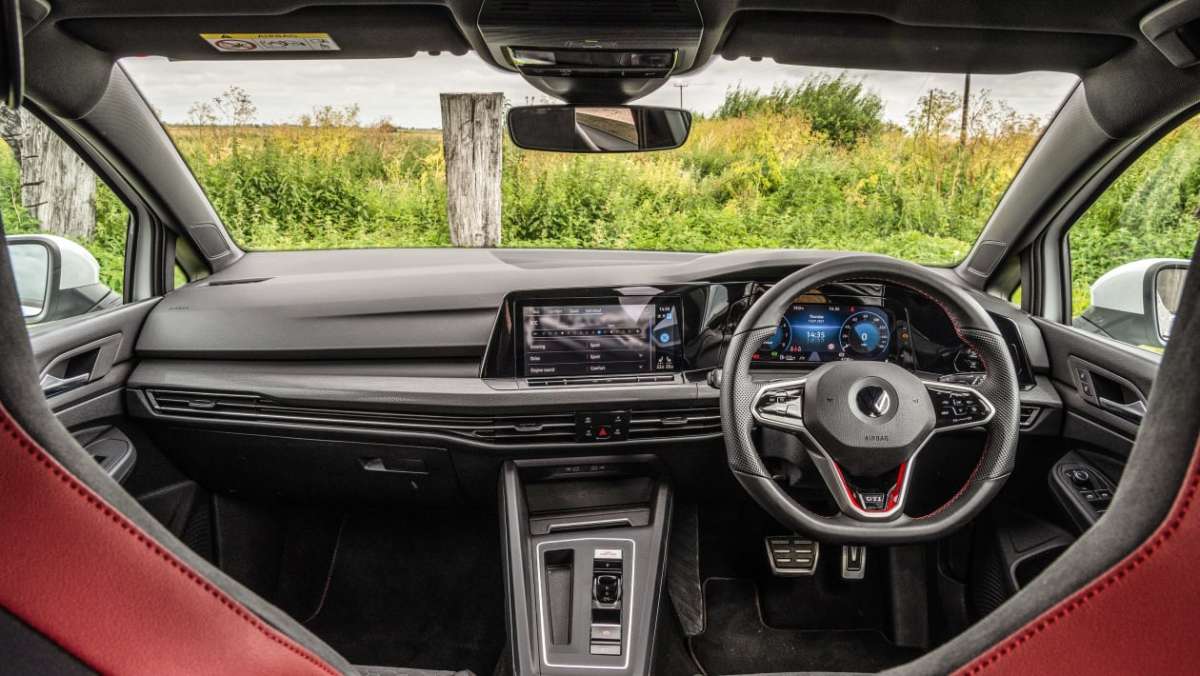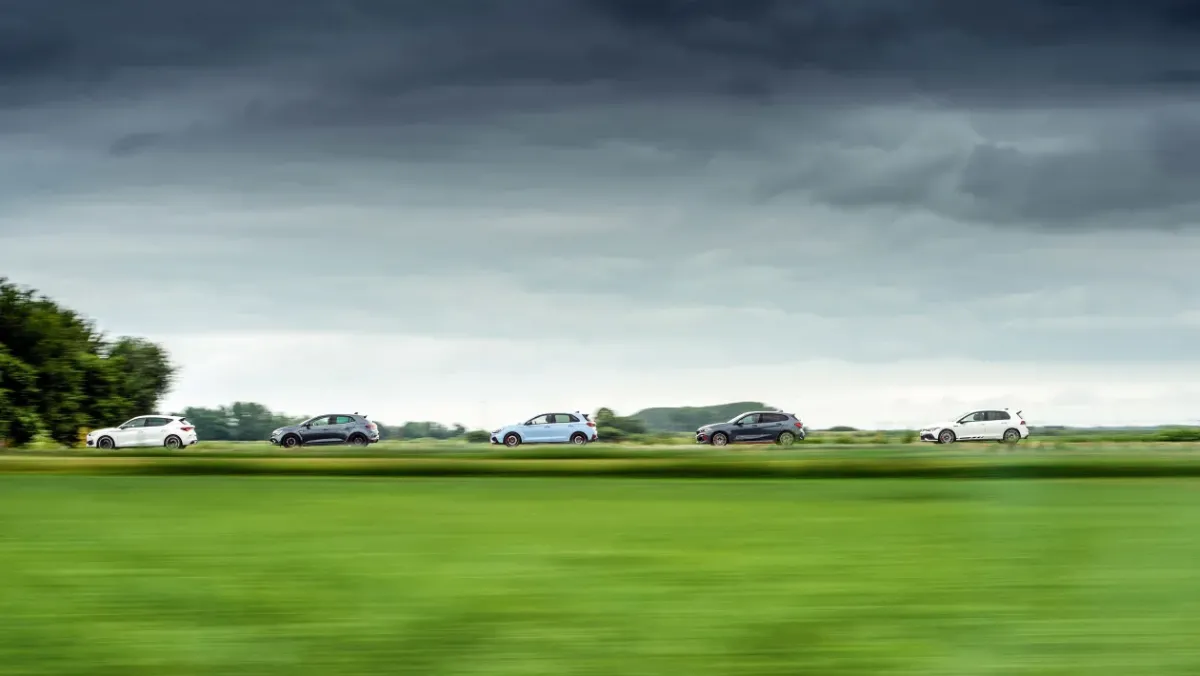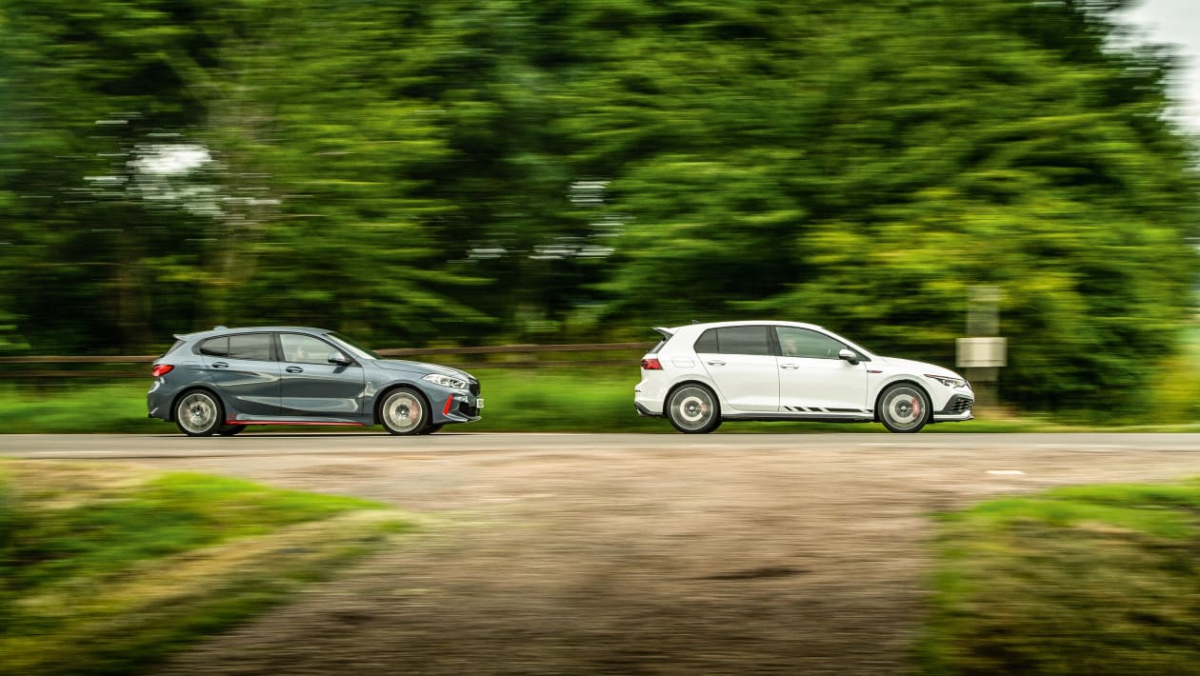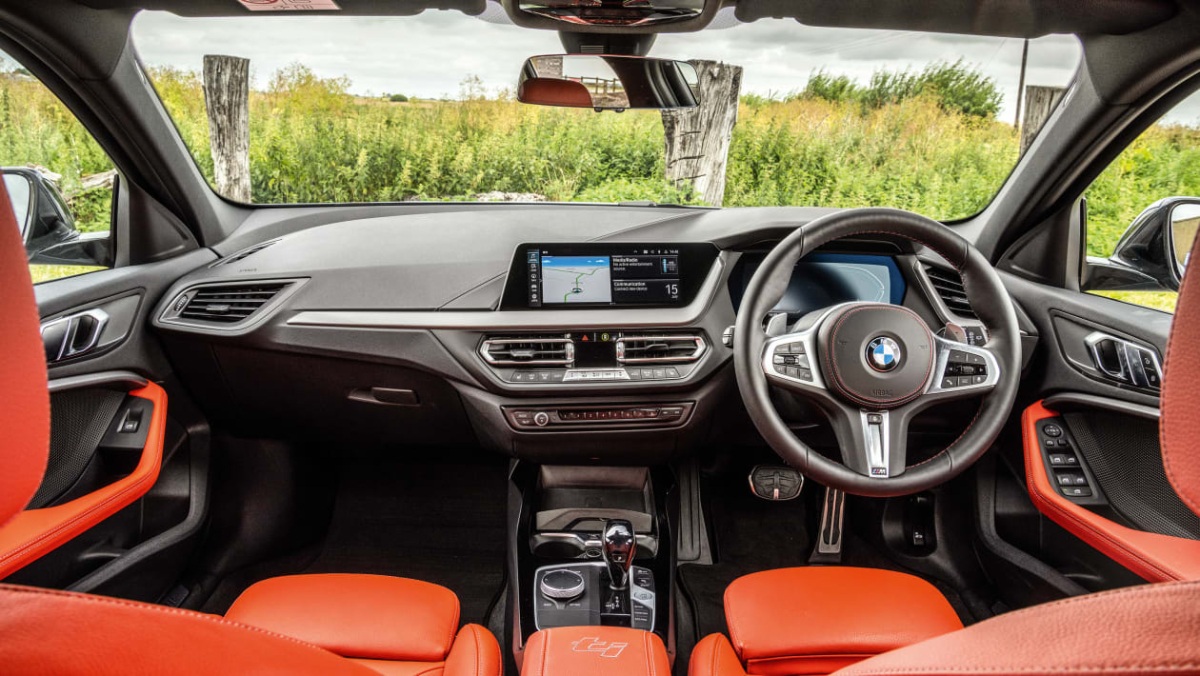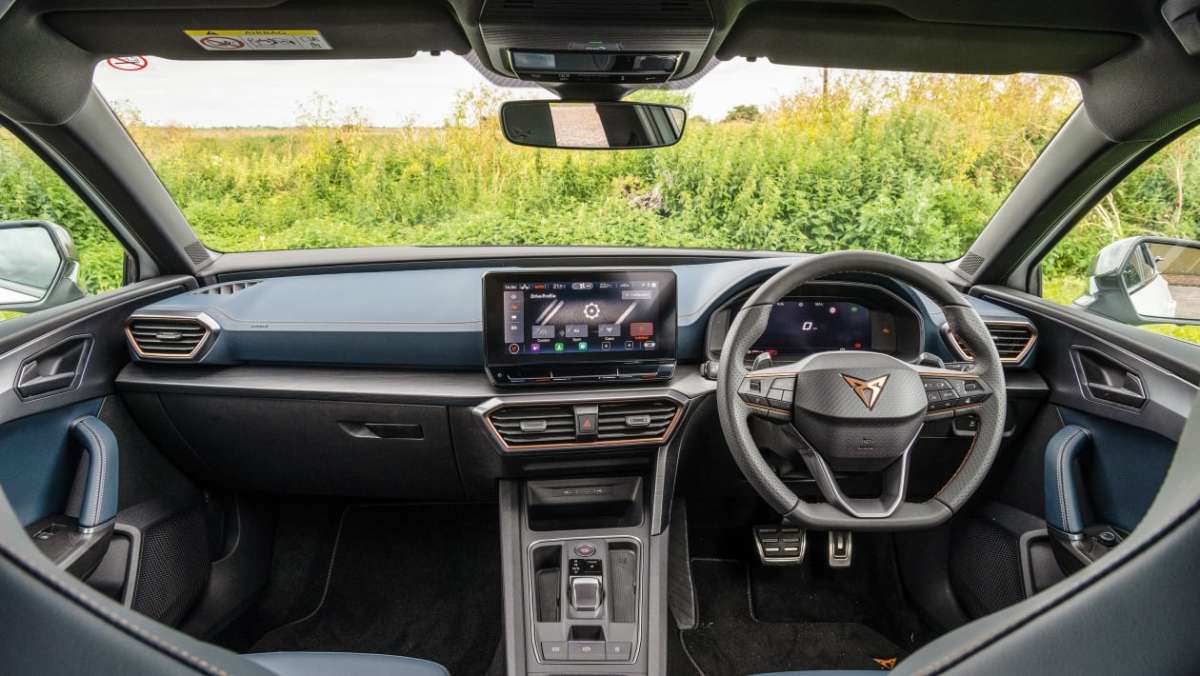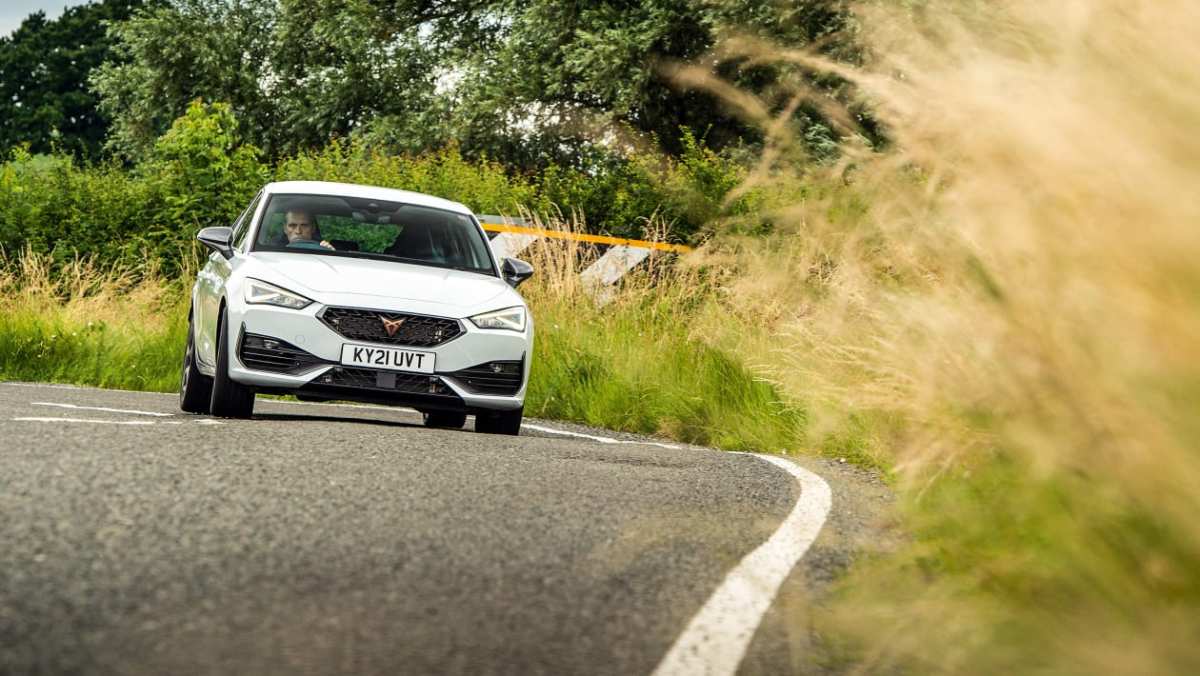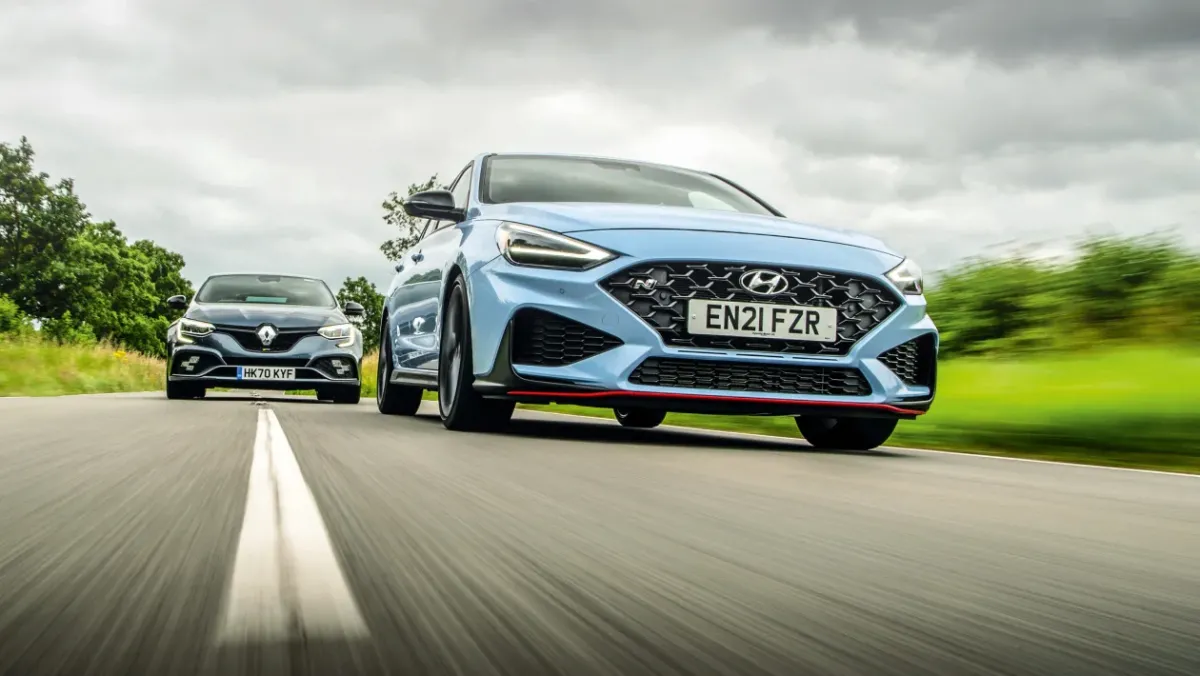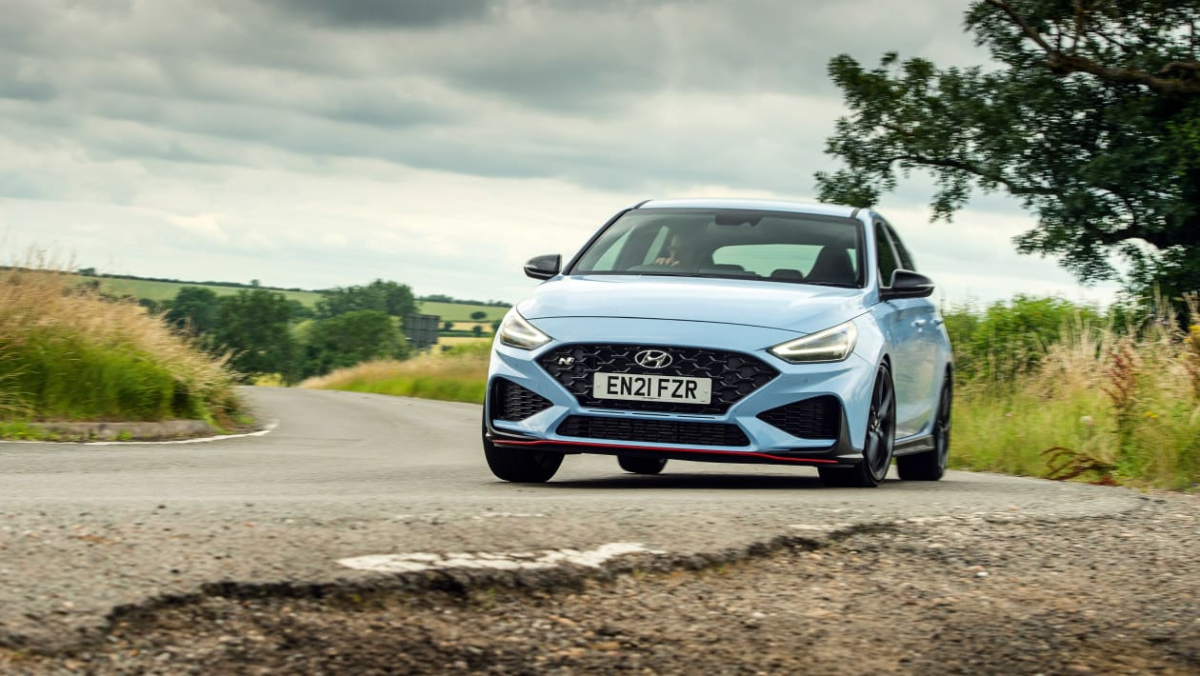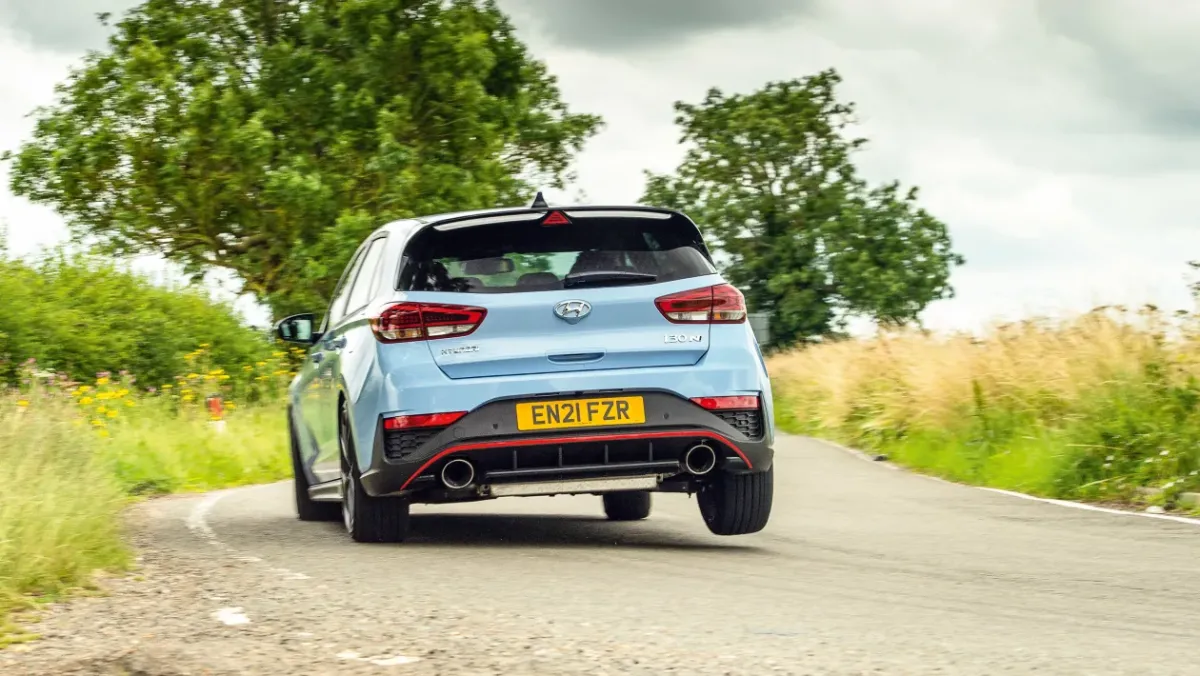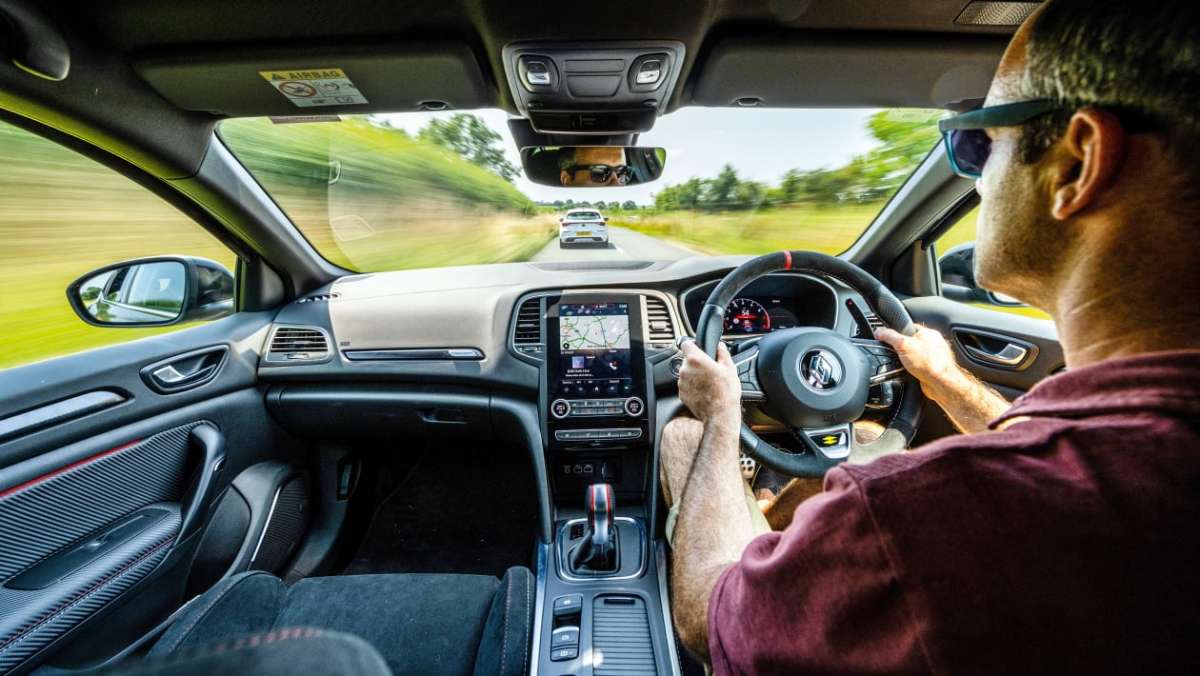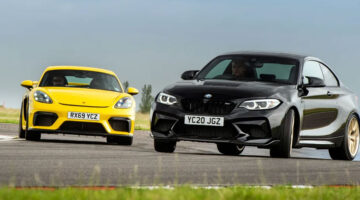Round 3 of our search to find the best hot hatch on sale sees the middleweights get in the ring. Which will go on to the finale: Leon, Mégane, i30 N, 128ti or Golf Clubsport?
Sometimes I’ll find myself drawn towards perching at the counter. Other times the quiet room round the back will become my home from home as I line up the espressos and try to think of what to write. Currently my favoured spot in my local coffee shop is in the corner, just to the left of the door as you walk in. It’s particularly good today because I can see the high street and the steady stream of interesting vehicles driving up it.
There must be a car meet going on somewhere nearby because intermingled with the monochrome drudgery of SUVs is a succession of hot hatches. The traffic lights up the road turn red and as an ST and a GTI roll to a halt they both decide to exercise their distinctly non-OEM exhausts. The five-cylinder sounds better, but the four-pot is producing the more anti-social cracks and bangs. It sounds like a minor small arms scuffle between Buckinghamshire drugs barons. The couple at the table next to me tut and sip their cappuccinos as a second volley clatters around the walls of the quaint market town.
> 2022 hot hatchback battle: hyper hatches
There is the occasional R or RS and some superminis scuttle by, but the majority are the middle ground. The solid ham sandwiches in the hot hatch buffet. Sure, most have been modified, but the heartland of the hot hatch seems to be the size and state of tune that is under consideration in the third of evo’s three hot hatch heats. They may not be as powerful as those in the first heat but they are more practical and powerful than those in the second. The question is, are any of them good enough to progress to the final to fight it out to be crowned king of the hot hatches? And are any of them good enough to take on the elephant in the car park, the Honda Civic Type R?
The Cupra Leon 300, Renault Mégane RS 300, BMW 128ti, Hyundai i30 N and Volkswagen Golf GTI Clubsport that we’ve gathered together all conform (mostly) to the recipe for a hot hatch in 2021: five doors, a turbocharged four-cylinder sending around 300bhp and 300lb ft to the front wheels, a 0-100kph time of just under six seconds, a top speed of 250kph or thereabouts and a weight of around 1440kg. With lone exceptions, there are just two pedals in the footwell and some sort of limited-slip differential between 19-inch front wheels. The look is subtle. A decal here, a diffuser there, but demure is the general design theme.
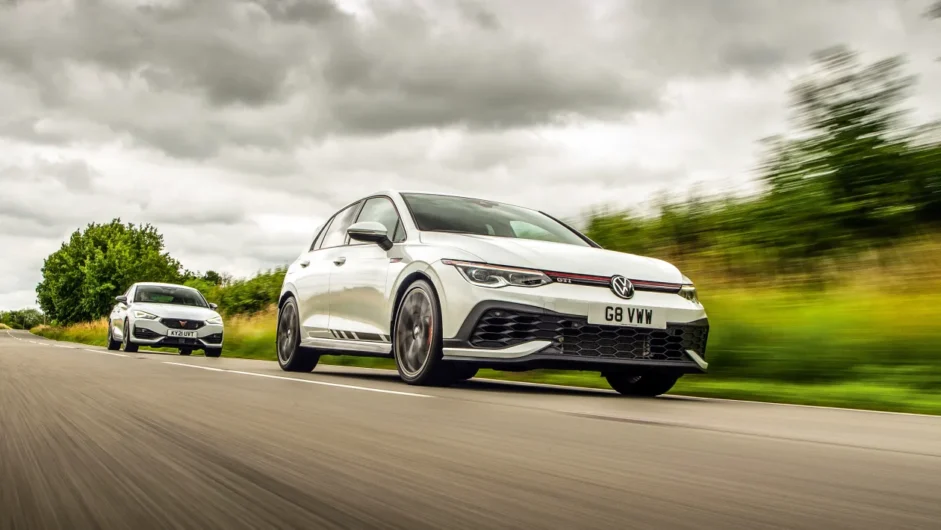
Perhaps the most distinctive in appearance is actually the Golf. Of course this is the Clubsport version of the GTI rather than the base spec car, but nonetheless the VW has historically been considered the most middle of the road, the most conservative, so it’s a slight surprise that it has the most presence in the group. There is an aggressive angulation from the tip of its roof spoiler down to its snout.
Inside, well, we’ve talked a lot about the lack of usability of the ancillary controls in Mk8 Golfs so I won’t repeat too much of that here. Suffice to say that it’s irritating to have to look down to turn the lights on or off and equally irritating that you can accidentally trigger the heated steering wheel during cornering. It’s a shame, because the wheel itself is good to hold, the seating position is pretty easy to adapt to fit and there is still that very particular Golf feeling of being in something that is unspectacularly secure and therefore relaxing.
We’ve become so used to the EA888 engine, which lurks beneath a bland black cover under the bonnet, that it’s easy to forget just how impressive it is. The strength and smoothness with which it pulls makes it the best in the group. Pretty much wherever you are in the rev range, you get a clean and immediate response to throttle inputs. Add in the crisp, quick changes from the DSG ’box and you have a no-nonsense drivetrain that consistently delivers.
This then tallies really well with the VAQ differential between the front wheels. I’ve been a fan of this clever, clutch-pack system for some time, because it feels so sophisticated and nuanced in the way it distributes the torque. Get hard on the throttle mid-corner and you quickly feel the front axle respond, the grip increasing and the line tightening. But the nice thing is that it doesn’t feel too aggressive and you can really work with it, managing the slip of the front tyres with throttle and steering to trim your line on the way out of a corner. Just as you would in a good rear-wheel-drive car.
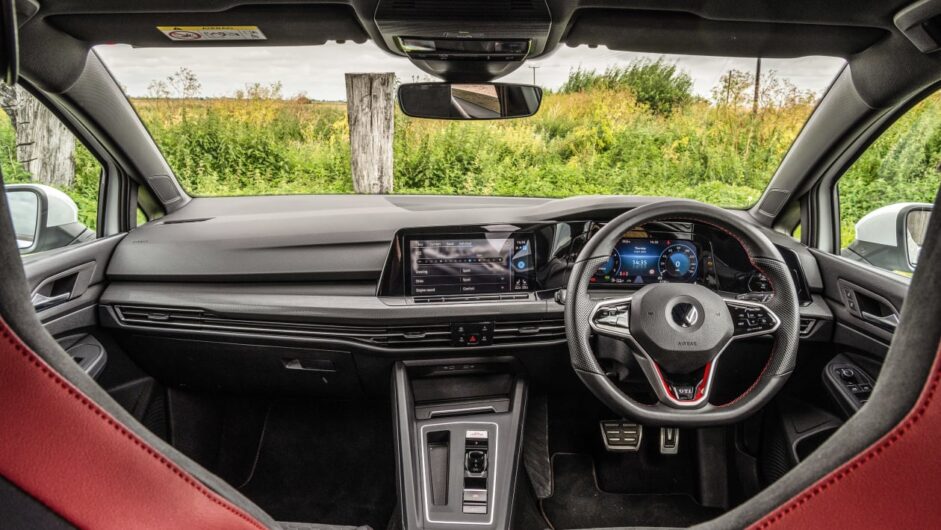
The downside to the Golf is that the rear doesn’t feel particularly mobile. The whole car stays fairly flat through corners, which I think helps make the most of that progressive, workable front end, but it feels more planted than playful. The engagement comes mostly from how you drive out of corners rather than how you get into them and that’s actually rather a nice thing on the road, where it’s easier to exploit the exits than the entries of corners.
Which brings us on to the other white car in this test. The Golf’s sibling. Some might say twin. The Cupra Leon is based on the same MQB Evo platform and has essentially the same EA888 engine, producing the same 296bhp and 295lb ft of torque, which is transmitted through the same seven-speed DSG drivetrain. However, the two cars are surprisingly different in character.
You would expect the Spanish car to look more flamboyant than its German counterpart, but curiously it looks bafflingly mundane. Not ugly, just not very sporty. It might be the white paint, but there is a general feeling that a fleeting glance would leave you dismissing it as a 1.5 TSI with some fancy wheels. Open the door and things improve, with the blue leather seats made from the hides of Smurfs, copper highlights around the vents and normal buttons on the wheel making it feel both more special and at the same time more practical than the Golf. Which is clever.
Set off down the same mixture of roads as driven in the Golf and the ride feels relatively similar. Like the Clubsport, this has adaptive dampers that give you more choice than a Dulux colour chart and somewhere in the middle is probably best on a bumpy B-road. But whether you prefer a touch more feedback or a mite more detachment, the overall way in which the cars deal with the rough and tumble feels nicely composed.
The difference comes when you start to tackle corners. Where the Golf feels planted, the Leon feels more agile but also more floaty. As you turn in, there is a lighter feeling to the steering and less sense of where the front end is, making it harder to be precise. The benefit is that where the Golf feels like it needs a slow-in-fast-out approach to every bend, the Leon gives you more options mid-corner, the tail feeling happier to rotate and help you adjust the angle of attack before the apex. However, it then loses out again on the exit of the corner as you don’t have the feeling that the nose is as hooked up when you get back on the throttle.
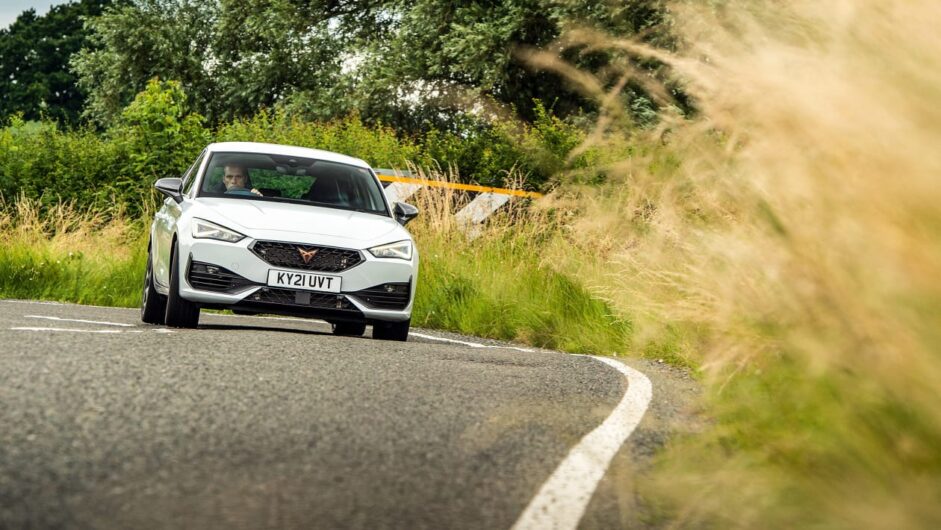
On a track, I suspect the Cupra could be more entertaining, but on the road the Golf feels the more keyed-in and more confidence inspiring to me. It has a more definite way in which it wants to be driven, making more concerted use of the VAQ differential.
What is even more surprising is the variance in the engines. The Cupra feels more turbocharged, a little less linear, with a sound that is more redolent of old Méganes with their gas rush noise. The Golf is no feast for the ears, but it has a gruffer note with a bit more growl to it. I’m not sure which is better, but they sound quite different and the VW actually feels marginally stronger. In terms of the shifts, there’s nothing to choose between them, although the more attractive paddles in the Cupra feel a bit more of a stretch for the fingers.
Talking of paddle position, the Renault seems like a good place to go next. The RS 300 is the bottom of what is now a two rung Mégane ladder, sitting beneath the RS Trophy version. As such it gets the more friendly Sport chassis but also foregoes an LSD – the only car here to do so. However, unlike any other hot hatch, it has four-wheel steering, with the ability to add up to 2.7 degrees of lock to the rear wheels. The 1.8-litre engine kicks out a VAG-matching 296bhp and torque is up to 310lb ft. The gearbox is the same six-speed DCT that is in the Alpine A110 – there’s no longer a manual option – and it feels nicely quick and engaging, but the paddles (just in case you thought I’d forgotten) are fixed and don’t extend low enough to fall naturally to hand.
In fact ergonomics are not a Mégane strong point, because as soon as you get in you also notice that the seating position is a bit awkward and the wheel doesn’t adjust very much for reach. The seats themselves are nicely supportive, but the plastics and overall interior feel like the cheapest of the group. Conversely, I think the exterior vies with the GTI Clubsport for being the best looking. I love that fact that Renault went to all the effort of giving it a bespoke bodyshell. The arches look fabulously muscular and the diffuser also gives the appearance of actually having some aerodynamic impact, which gives the car a certain integrity.
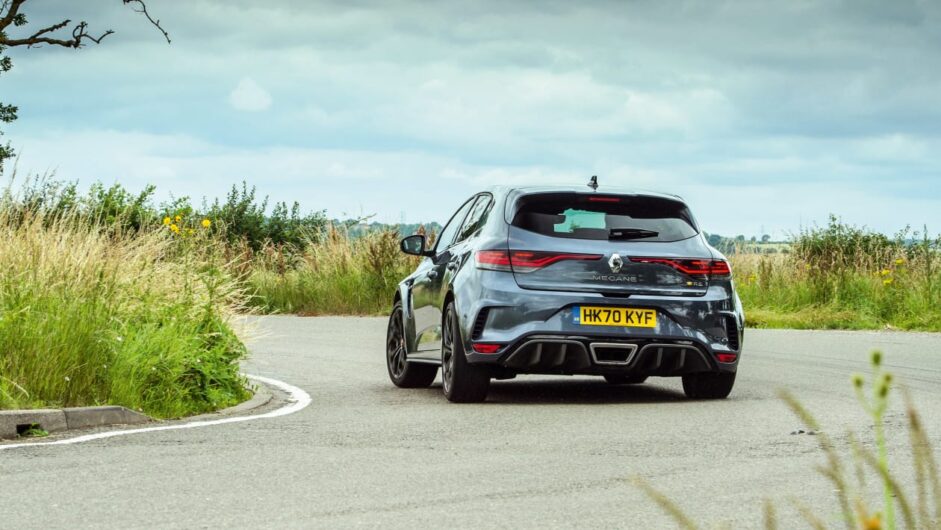
All five cars have various driving modes but none is subjected to a bigger transformation by them than the Mégane. Left in its standard setting, it feels pretty humdrum. However, select Race via the ‘RS Drive’ button on the transmission tunnel or the big, portrait touchscreen and it turns into one of the liveliest cars in the test. The engine feels even more demonstrably turbocharged and boosty than the Leon’s, the crackles on the overrun from the central exhaust even more theatrical than those from the VW and Hyundai. With the 4Control system dialled up it has an almost hyper-agile feeling on turn-in, the whole car pivoting like Ross Geller mapped the ECU.
As a result, it’s a car that is at its most fun when the corner is well sighted and you can turn in with real commitment on entry. You don’t get a huge amount of feel through the steering, so it’s a car you need to learn and trust because you can certainly turn hard enough to get the rear rotating into oversteer. Sadly, because there is no LSD, the aggression that you can attack the first part of a corner with can’t really be matched on the exit. You need to temper your throttle inputs because otherwise you’ll scrappily spin up an inside wheel and understeer wide.
The solution would seem to be to notch your pace back by a couple of tenths and get into a more measured flow. And it sort of works – certainly on quicker bits of road – but then there is this feeling that you’re always missing out a little bit by not making full use of that incredible agility. It’s frustrating, because the RS 300 rides well, its engine is keen and when you find the right corner it is arguably the most exciting car in the group. Just like the Cupra, while it’s fun on the road, it might have done even better if this was a track test where you could fully exploit its handling all the time.
If, on the other hand, this was a static, showroom test, with all the cars lined up in a glass box with some free coffee and a little corner of branded keyrings and T-shirts, then the BMW would probably win. Not because the splashes of red on the outside are especially attractive, but because when you open the door the slightly more premium nature of the interior is immediately evident. The leather feels thicker than in the Cupra, while the stitching on the armrests and the tricolour flashes on the seatbelts are nicely redolent of a proper motorsport past. The seats hold your hips well and there are multiple options for accessing the infotainment. It’s impressive, especially given that it’s as affordable as the Mégane and Hyundai.
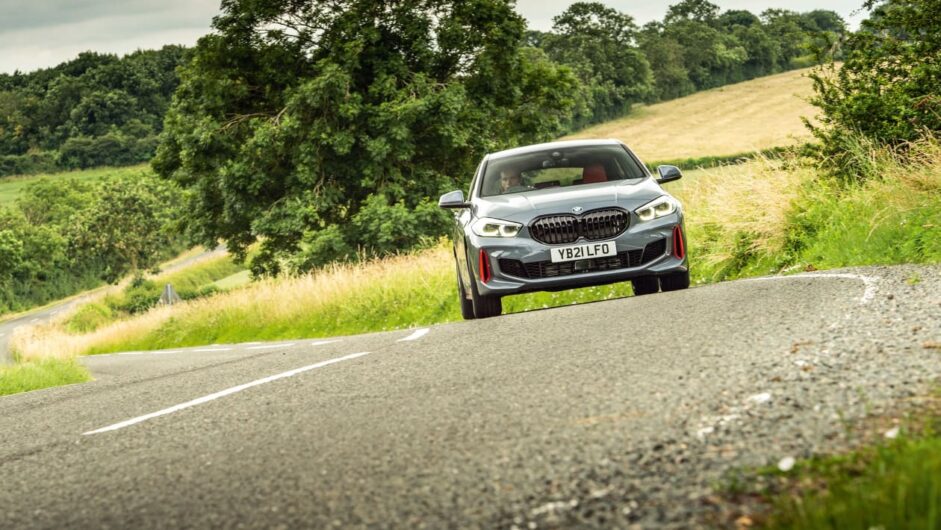
Get in and the seating position is classically BMW, with your legs stretched out a little more than in the others. There is something about this driving position that still makes me think the 1-series should be rear-wheel drive, though. As soon as you accelerate out of the showroom and down the road for the test drive, however, there is no doubt where the power is going, because you instantly notice how busy the nose of the car is. The front tyres seem as easily distracted as a pair of toddlers in a toy shop: ‘Oh look at this camber! No, over here, come and see this imperfection!’
It’s a slightly soft, almost remote type of torque steer, which might sound endearing and engaging, but actually just makes the car feel imprecise and tricky to place. It’s not the fault of the suspension as such, as the passive damper set-up strikes a nice balance that gives a decent sense of connection with the road, while still taking just enough harshness off the bumps. It edges the Golf and Leon for ride quality. And if you’re leaning on the fundamental balance of the chassis without any torque going through the front axle the handling feels much more transparent. But as soon as you get on the throttle the picture gets a bit muddy.
The locking characteristics of the limited-slip differential were actually softened a little for the 128ti compared with the 135i xDrive, but I’m not sure this was a great idea. It has arguably reduced the sense of connection and control over the front wheels in a straight line, and then pulling out of corners with some steering angle you can still feel the inside wheel losing traction rather than the whole front end digging in and tightening the line as it does in the Golf.
Even more concerning for the BMW is the fact that its drivetrain feels the weakest in the test. You could argue that’s not surprising, because with 261bhp it has the least power, but it’s not that far behind the Hyundai (276bhp) and its 295lb ft of torque is a match for the others. In fact I don’t think it’s the engine’s fault; I think it is down to the automatic gearbox. In isolation you can get used to it, but the moment you put it back-to-back with the dual clutch ’boxes in this test it suddenly feels like using a spoon to cut your food instead of a steak knife. The whole delivery just seems slightly soft and lacking in urgency, even with Sport+ mode engaged.
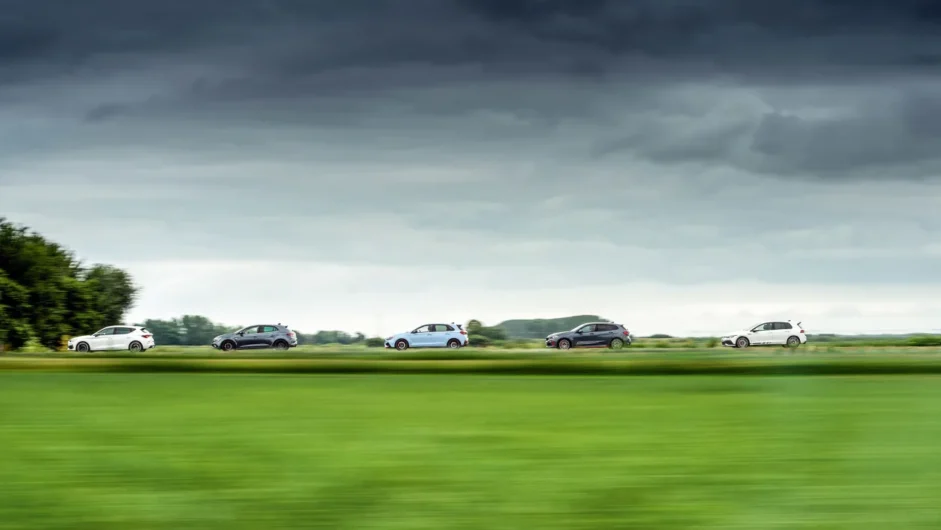
Which leaves us with the i30 N in its distinctive but curiously calming shade of baby blue. A cool colour for a hot hatch. Its shape is rather similar to that of the BMW, but the two cars are at opposite ends of the rankings in this test and one can’t help but wonder whether things might have been different if Albert Biermann hadn’t been lured away from Munich by Hyundai seven years ago.
Frankly, whichever of the other four you have stepped out of, there is a refreshing honesty and simplicity to the South Korean car. Open the boot and your eye is immediately drawn to the rear strut brace. It’s nothing fancy, just some ordinary bits of black tubing welded together. But its lack of pretension gives you confidence. If there is no aesthetic merit then you know it must be there for a reason – it’s the antithesis of the shiny red bar that serves no purpose in the back of the latest Mini GP.
It feels a pleasing generation behind the others when you get into the driver’s seat, with a greater reliance on physical buttons in the cabin. It doesn’t have quite such a swish look as a result, but it’s nicely unfussy in the way it works. It feels well put together too. Add in the excellent new optional lightweight bucket seats, the well placed pedals too, and you have a cockpit that’s as reassuringly easy to use as a toaster.
Of course the biggest throwback is the extra pedal. You can now have the i30 N with a dual-clutch transmission (see last month’s Driven), but it is the only car in this test with the option of a manual gearbox and there’s no getting away from the fact that it really adds to the experience. The shift is chunky but doesn’t baulk when you rush it, and although the pedals are well placed for heel and toe, the adjustable rev-match function also lets you retain the smoothness but be a bit lazy if you want.
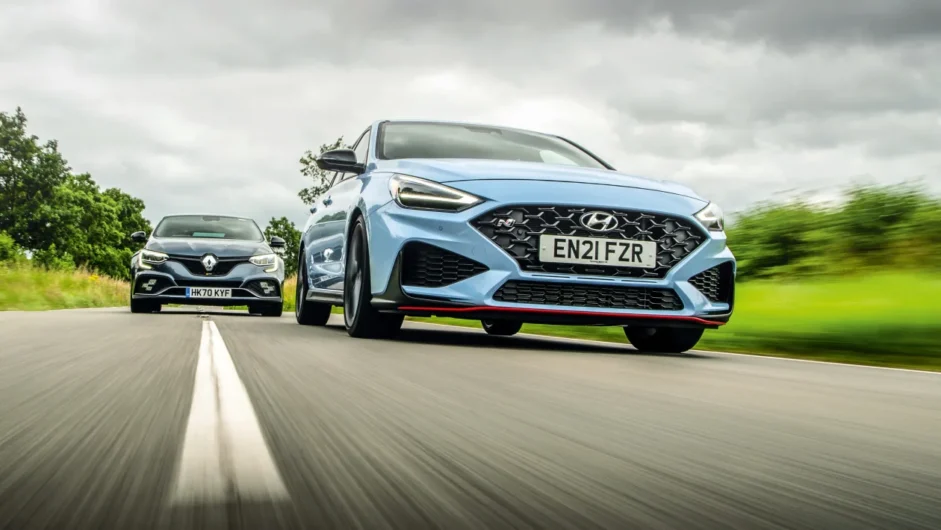
There is a meatiness to the steering as well and a lovely sense of connection to the road through the suspension. It’s not a delicate car but neither is it in the slightest bit lazy in its responses. It’s a little like the latest BMW M4 Competition to that extent. And like that car there’s a slightly bewildering plethora of drive modes to get your head around. The blue button slung in the lower left quarter of the steering wheel cycles through Normal, Sport and Eco and the middle of those is worth using as a default for everyday use. The other big blue button is for the N and Custom modes. The first of those, the everything-up-to-(te)N mode, firms up the suspension much too much for the road. However, if you spend a bit of time tailoring the Custom mode (principally softening the dampers, but also dialling the steering back to Sport) then you get all of the fun traits without the compromise.
The limited-slip diff doesn’t feel as sophisticated as the Golf’s but it gets the job done, and while the engine isn’t dripping with character it is plenty strong enough. The end result is a car that doesn’t feel exceptional in any one area but just gels incredibly well so that it never leaves you guessing. You can chuck it around with confidence and it feels more mechanical than all the others in the test, more engaging at any speed.
> 2022 hot hatchback battle: superminis
All of which makes the Hyundai the clear winner from the quintet. It isn’t a bargain any more but it is still cheaper than the Cupra and VW. The only one that might initially look better value is the BMW, but that, I’m afraid, is the one that we would recommend least. It’s just not a very precise car. That’s partly because of the torque converter, but also because of the slightly disconnected-feeling steering and the torque steer. As Adam Towler comments: ‘You can go through a corner ten times and each time you’d go through it in a different way, but not by choice.’
That’s the top and the tail then. In the middle it’s all much closer. I like a lot of what the GTI Clubsport does. There is a real purpose to the way it drives and a sense of connection when you load it up. However, it is easily the most expensive in the test (even before you add the essential but optional DCC adaptive dampers) and I can’t help but feel the steering – not to mention the interior – isn’t as good as it was on the equivalent model in the previous generation GTI.
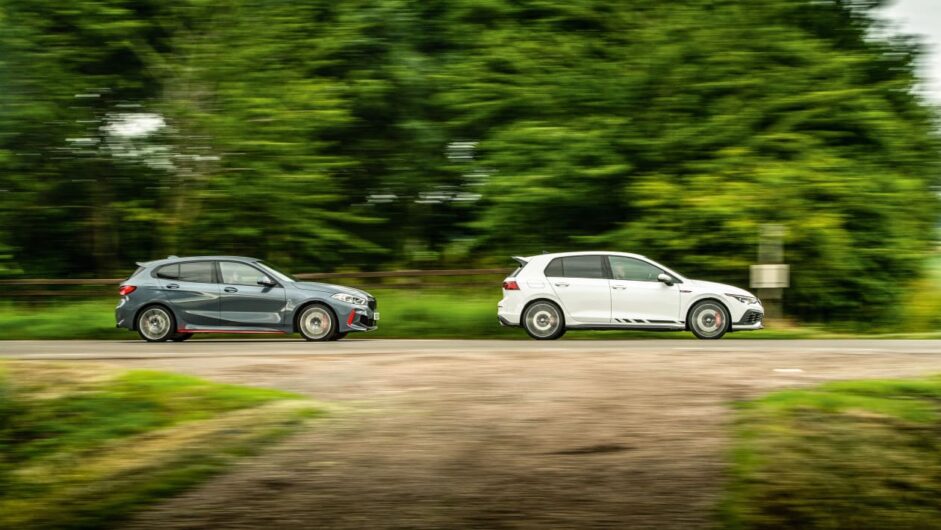
Adam was more of a fan of the Leon, noting that ‘once it’s cornering it’s keener. You can feel it using the rear axle to turn the car more and that gives it a greater sense of agility than the Golf.’ Even he admitted that the Cupra ‘looks totally forgettable’, however. In the end it’s probably honours even between the MQB Evo siblings, which is no doubt just how the VW group wants it.Advertisement – Article continues below
Which leaves Renault offering an intriguing but less polished alternative. This generation of Mégane has always felt frustratingly nearly but not quite there. An RS 300 with an LSD and a manual ’box might be the sweet spot we’ve been searching for, but such a thing doesn’t exist. Nonetheless the RS 300 is delightfully agile and always feels full of brio, so you leave it wanting more in both the good and bad sense.
Ultimately the hot hatch seems like a simple formula; it has to be the great all-rounder. But I think this group shows that it has become trickier to achieve. Performance is not the problem because all the cars in this test are more than quick enough down a road. Grip and power see to that. But as the base cars get bigger and more cosseting, so it is getting, perhaps understandably, more difficult to make this category of hot hatch truly engaging and tactile. Thankfully the i30 N proves it can still be done and as a result I suspect there might be many more Hyundais visible through the coffee shop window in years to come.
Specs
| Cupra Leon 300 | Renault Mégane RS 300 | Hyundai i30 N | BMW 128ti | Volkswagen Golf GTI Clubsport | |
| Engine | In-line 4-cyl, 1984cc, turbo | In-line 4-cyl, 1798cc, turbo | In-line 4-cyl, 1998cc, turbo | In-line 4-cyl, 1998cc, turbo | In-line 4-cyl, 1984cc, turbo |
| Power | 296bhp @ 5300-6500rpm | 296bhp @ 6000rpm | 276bhp @ 6000rpm | 261bhp @ 4750-6500rpm | 296bhp @ 5000rpm |
| Torque | 295lb ft @ 2000-5200rpm | 310lb ft @ 4000rpm | 289lb ft @ 1950-4600rpm | 295lb ft @ 1750-4500rpm | 295lb ft @ 2000-5200rpm |
| Weight | 1415kg | 1443kg | 1419kg | 1445kg | 1461kg |
| Power-to-weight | 213bhp/ton | 209bhp/ton | 198bhp/ton | 184bhp/ton | 206bhp/ton |
| 0-100kph | 5.7sec | 5.7sec | 5.9sec | 6.1sec | 5.6sec |
| Top speed | 250kph | 250kph | 250kph | 250kph | 250kph |
| Basic price | $43,650 | $41,208 | $41,405 | $41,575 | $46,535 |
> 2022 hot hatchback battle: the final
This article originally appeared at evo.co.uk
Copyright © evo UK, Autovia Publishing


